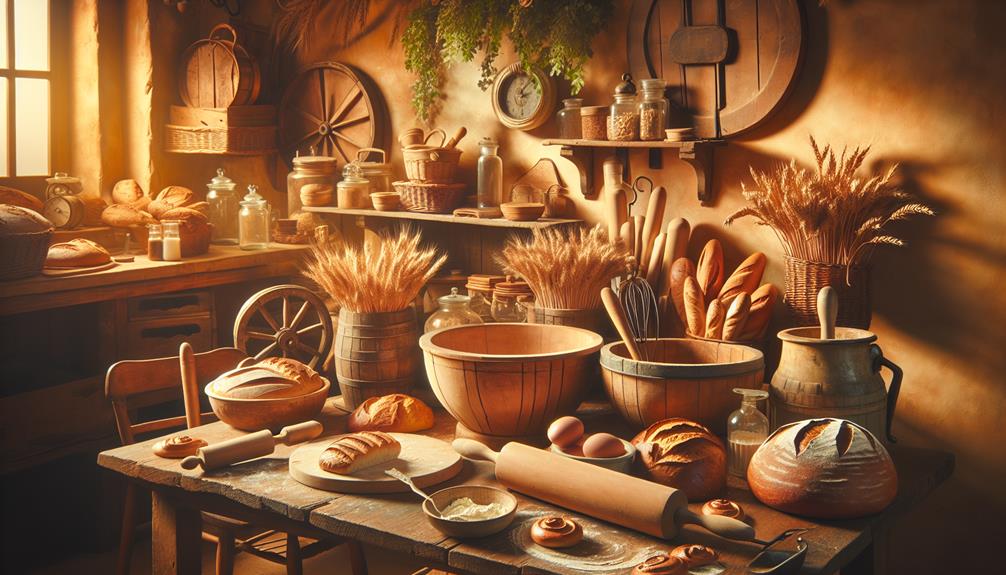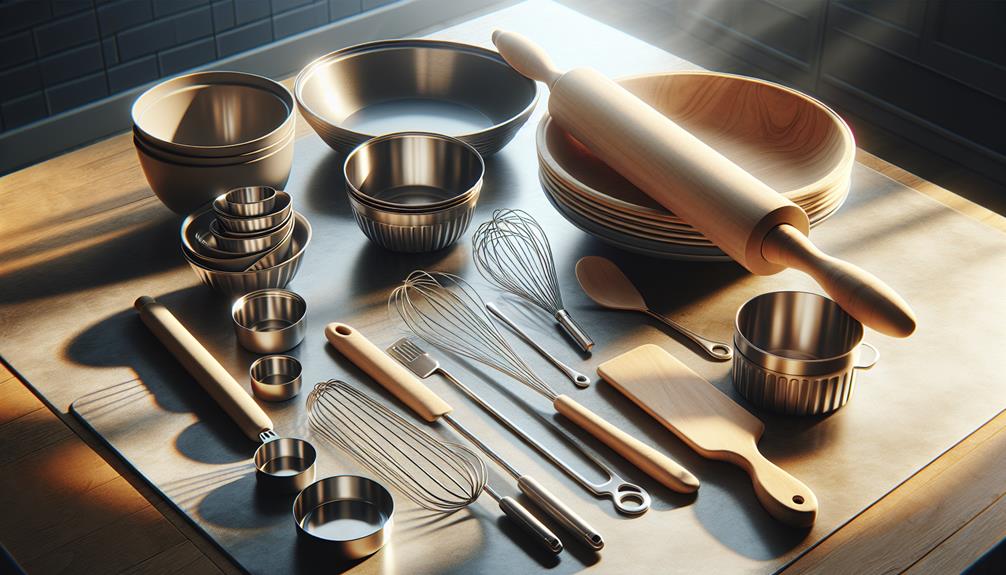As you set out on the journey to revive the art of baketech, you'll soon realize that it's not just about dusting off old recipes, but about mastering the heritage baking techniques that define this craft. You'll need to get familiar with the nuances of ancient grains, learn the patience-testing art of traditional laminating, and understand the slow, gentle dance of fermentation. But that's just the beginning – there's so much more to uncover, from the secrets of hand-shaped breads to the subtle charms of wood-fired ovens. Where will you start, and what techniques will you prioritize to bring this timeless art back to life? As you dive deeper into the world of baketech, consider how you can apply digital banking strategies to streamline your processes and reach a wider audience. Embracing technology can help you connect with fellow baking enthusiasts, share your knowledge, and ultimately preserve and promote the art of heritage baking for generations to come. By combining traditional techniques with modern innovation, you can create a truly unique and impactful revival of this timeless craft.
Embracing Ancient Grain Recipes
As you venture into the world of heritage baking, you'll discover that embracing ancient grain recipes is a journey that not only revives forgotten flavors but also connects you to the culinary traditions of our ancestors. You'll soon realize that ancient grains like Kamut, Spelt, and Emmer hold secrets to healthier and more nutritious baked goods. Understanding the Grain Origins of these ancient varieties will help you appreciate their unique characteristics and adapt them to modern recipes.
Incorporating ancient grains into your baking routine means you'll be providing your customers with Ancient Nutrition that's rich in fiber, protein, and minerals. These grains are naturally higher in antioxidants and have a lower glycemic index compared to modern wheat. By using ancient grains, you'll create baked goods that are not only delicious but also offer a range of health benefits. As you experiment with ancient grain recipes, you'll find that the unique flavors and textures will set your bakery apart from the rest. So, take the first step in this culinary journey and discover the wonders of ancient grain baking.
Reviving Lost Art of Laminating
Your hands will soon become skilled at layering dough and fat, as you master the ancient technique of laminating, a process that requires patience, precision, and practice to produce flaky, tender pastries and breads. As you explore the world of laminating, you'll discover the importance of Layering Fundamentals. It's all about creating a harmonious balance between dough and fat, where each layer is carefully placed to create a delicate, flaky texture. Think of it as Dough Choreography – every move, every fold, every roll is a carefully orchestrated step that results in a masterpiece.
To achieve this, you'll need to develop a gentle touch, one that coaxes the dough into submission without overworking it. You'll learn to gauge the perfect temperature, the ideal resting time, and the precise moment to fold and roll. With each attempt, your skills will improve, and your pastries will become lighter, airier, and more divine. As you perfect the art of laminating, you'll gain access to a world of possibilities – from croissants to puff pastry, and beyond. The journey may be long, but the reward is well worth it: tender, flaky, and utterly irresistible baked goods that will leave everyone wanting more.
Preserving Hand-Shaped Breads Tradition
As you explore the world of heritage baking, you'll find that shaping bread by hand is an essential part of preserving traditional techniques. By doing so, you're not only creating a unique, artisanal product, but you're also honoring the ancient methods that have been passed down through generations. Now, let's examine the significance of hand-shaping and how it contributes to the preservation of this timeless craft.
Shaping by Hand Matters
You take a significant step towards preserving the heritage of hand-shaped breads when you commit to shaping dough by hand. This traditional technique requires skill and patience, but the rewards are well worth the effort. As you work the dough, you develop finger pressure and hand-eye coordination, essential skills for creating beautiful, uniform loaves. With every gentle press and delicate fold, you're honing your craft and connecting with the generations of bakers who came before you. By shaping by hand, you're able to feel the dough's texture and respond to its needs, resulting in a more nuanced and complex final product. The imperfections that come with hand-shaping are a badge of honor, a symbol of the human touch that's absent in machine-made breads. As you shape and mold the dough, you're not just creating a loaf – you're preserving a piece of history. So take your time, focus on the process, and let the rhythm of hand-shaping become a meditation.
Preserving Ancient Methods
By adopting ancient methods, bread enthusiasts can safeguard the heritage of hand-shaped breads, ensuring that the craft of shaping dough by hand remains vibrant and alive for generations to come. You can start by reviving ancient toolcraft, such as using wooden spoons and wicker baskets to shape and proof your dough. These traditional tools not only add character to your bread but also connect you to the bakers of the past.
Diving into forgotten archives, you'll discover recipes and techniques that have been lost over time. You might stumble upon an ancient recipe for a rustic bread that's been passed down through generations of bakers. By recreating these recipes, you'll be preserving a piece of history and keeping the tradition of hand-shaped breads alive. As you experiment with ancient methods, you'll develop a deeper appreciation for the craft of bread-making and the bakers who came before you. By preserving these ancient techniques, you'll be ensuring that the art of hand-shaped breads continues to thrive for years to come.
The Art of Slow Fermentation
Slow fermentation transforms dough into a culinary masterpiece, coaxing out complex flavors and textures that set heritage breads apart from their commercial counterparts. As you venture into the world of slow fermentation, you'll discover the intricacies of Fermentation Science. This process is an art that requires patience, as it takes time for yeast and bacteria to break down complex carbohydrates, producing a symphony of Flavor Profiles. The slower fermentation process allows for a more gradual release of enzymes, resulting in a deeper, more nuanced flavor. You'll notice hints of sourness, sweetness, and umami, which are balanced by the tanginess of lactic acid. As you master the art of slow fermentation, you'll be able to create breads with a rich, velvety crumb and a crust that's crispy yet tender. By grasping the science behind slow fermentation, you'll discover the secrets to crafting truly exceptional heritage breads that will leave a lasting impression on anyone who takes a bite.
Bringing Back Forgotten Flavors
As artisanal bakers venture into the domain of heritage baking, they uncover a treasure trove of forgotten flavors, hidden away in ancient recipes and dusty tomes. You'll discover that these flavors aren't just about adding a pinch of this or that; they're about understanding the cultural context in which they were born. Flavor profiling becomes essential in heritage baking, as you need to balance and harmonize the complex flavors of yesteryear. You'll find that certain flavor combinations, like cardamom and rosewater, were staples in ancient Middle Eastern baking, while others, like anise and citrus, dominated the Mediterranean scene.
Through cultural exchange, you'll uncover the secrets of heritage baking. You'll learn how ancient traders and travelers introduced new ingredients, techniques, and ideas, shaping the flavor profiles of entire regions. By embracing these forgotten flavors, you're not only reviving a piece of history but also creating a new narrative that honors the past while innovating for the future. As you experiment with these flavors, remember that heritage baking is about telling a story – one that's rich, complex, and full of character.
Honoring Traditional Mixing Methods
You'll find that the art of heritage baking extends beyond flavor profiling to the traditional mixing methods that brought these flavors to life. As you explore the world of heritage baking, you'll discover that mechanical limitations of the past actually contributed to the unique characteristics of traditional breads. For instance, the slow, laborious process of mixing and kneading by hand allowed for a more intimate connection with the dough, resulting in a more nuanced flavor profile. Additionally, these traditional mixing methods hold significant cultural significance, as they were often passed down through generations and became an integral part of family traditions and community bonding. By honoring these traditional mixing methods, you're not only preserving the heritage of bread-making but also paying homage to the people and cultures that came before us. So, take the time to slow down, get your hands dirty, and experience the tactile joy of mixing and kneading by hand – your bread, and your heritage, will thank you.
Mastering Wood-Fired Oven Techniques
As you step into the world of wood-fired oven baking, you'll quickly realize that mastering the flames and temperature control is key to achieving that perfect crust. You'll need to learn how to heat the oven properly, which can be a challenge, but with practice, you'll get the hang of it. By understanding these fundamental techniques, you'll be well on your way to baking like a pro in a wood-fired oven.
Flames and Temperature Control
Master the art of temperature control by learning to read the subtle language of flames in your wood-fired oven, where a gentle flicker can signal a perfectly heated hearth. You'll develop a fiery palette, attuned to the nuances of flame color and movement, allowing you to intuitively adjust your firing techniques. As you gain thermal mastery, you'll be able to precision-control your oven's temperature, coaxing out the perfect crust or crumb from your baked goods.
Pay attention to the flame's height, color, and dance. A lazy, yellow flame indicates a cooler oven, while a tall, blue flame signals intense heat. You'll learn to modulate the fire, adding smaller logs to maintain a consistent temperature or larger ones to boost the heat. Practice makes perfect, so don't be discouraged if it takes time to develop your skills. With patience and persistence, you'll become a master of flames and temperature control, tapping the full potential of your wood-fired oven and producing truly exceptional baked goods.
Heating the Oven Properly
To heat your wood-fired oven properly, start by building a small fire with kindling and gradually adding larger logs to create a robust flame. As the fire grows, you'll want to adjust the airflow to maintain a consistent temperature. Once you've reached the desired heat, you must calibrate your oven to achieve even heat distribution. This means checking the temperature in different areas of the oven to identify any hotspots.
To achieve uniform heat distribution, you'll need to rotate your baking stone or racks periodically. This guarantees that your baked goods cook consistently, without burning or undercooking in certain areas. Proper oven calibration also helps you maintain a consistent baking schedule, which is critical for producing high-quality bread and pastries.
Resurrecting Heritage Yeast Strains
You're likely familiar with the importance of yeast in bread making, but did you know that many heritage yeast strains have been lost over time due to the rise of commercial yeast? This has resulted in a significant loss of diversity and flavor in modern bread. To combat this, bakers and scientists are engaging in "yeast hunting" – a process of tracking down and isolating heritage yeast strains from traditional bread-making regions.
Through "microbe mapping," researchers can identify and analyze the unique microbial populations present in these heritage strains. This information can then be used to recreate and propagate the yeast, allowing bakers to once again work with these unique and flavorful microorganisms. By resurrecting these heritage yeast strains, you can add depth and character to your bread, and help preserve the rich cultural heritage of traditional bread-making practices. With the right techniques and tools, you can join the movement to revive these lost yeast strains and bring back the complexity and nuance of traditional bread.
Protecting Regional Baking Identities
As bakers and scientists work to revive heritage yeast strains, they're also recognizing the importance of preserving regional baking identities, which are often closely tied to specific yeast strains and traditional techniques. You, as a baker, know that regional identities are what set your baked goods apart from others. They're the result of cultural exchange, community roots, and generations of passed-down knowledge. Preserving these identities means more than just saving recipes; it's about protecting the cultural heritage of your region.
When you adopt heritage techniques and ingredients, you're not only creating unique products but also contributing to the preservation of your community's history. By doing so, you're helping to build a sense of pride and ownership among locals, which can lead to a stronger sense of community. In addition, regional baking identities can serve as a catalyst for cultural exchange, allowing you to share your traditions with others while learning from theirs. By embracing and celebrating these differences, you're enriching the baking world as a whole.
Celebrating Seasonal Ingredient Cycles
As you explore the world of heritage baking, you'll discover that celebrating seasonal ingredient cycles is key to creating truly exceptional treats. By embracing what's fresh and local, you'll capture the essence of each season in every bite. Now, let's take a closer look at how harvesting local flavors can elevate your baking game.
Harvesting Local Flavors
What role do seasonal ingredient cycles play in shaping the flavor profiles of your baked goods, and how can you tap into this natural rhythm to create more authentic, locally inspired treats? By embracing the changing seasons, you can craft baked goods that reflect the unique character of your region. Take farm tours to connect with local farmers and learn about the varieties they grow. This will give you a deeper understanding of the ingredients you're working with and inspire new flavor combinations.
Terroir tasting, a sensory exploration of local ingredients, can also help you develop a more nuanced appreciation for the flavors and textures of your region. By paying attention to the subtle differences in flavor and aroma between, say, a summer peach and a winter apple, you can create baked goods that are truly rooted in your local environment. As you harvest local flavors, remember to keep your recipes flexible and adaptable, allowing the seasons to guide your creativity. By doing so, you'll create baked goods that are not only delicious but also deeply connected to the place you call home.
Freshness in Every Bite
Your commitment to celebrating seasonal ingredient cycles means that every bite of your baked goods bursts with freshness, thanks to the thoughtful pairing of ingredients at their peak flavor and texture. By embracing the changing seasons, you're able to craft recipes that showcase the unique characteristics of each ingredient, resulting in baked goods that are truly exceptional.
When you prioritize seasonal ingredients, you're able to achieve ideal texture retention, ensuring that every bite is tender, yet firm, and bursting with flavor. The nuanced flavor profiles of seasonal ingredients allow you to craft complex, layered flavor profiles that will leave customers wanting more. For example, using ripe summer berries in a tart will yield a sweet-tart flavor profile that's simply irresistible. By staying attuned to the rhythms of nature, you're able to create baked goods that are truly alive with flavor and texture. This dedication to seasonal ingredients is what sets heritage baking apart, and it's an essential element of the Baketech revival.
Frequently Asked Questions
What Modern Tools Can Aid in Heritage Baking Technique Preservation?
You'll find that modern tools like digital archiving and automated mixing can really help preserve heritage baking techniques. By digitizing traditional recipes and methods, you'll safeguard their longevity, and automated mixing will streamline the process.
How Do I Adapt Heritage Recipes for Modern Ingredient Availability?
You'll need to master ingredient substitution and recipe reengineering to adapt heritage recipes for modern ingredient availability, ensuring the same flavors and textures while swapping out hard-to-find or outdated ingredients for their contemporary counterparts.
Can Heritage Baking Techniques Be Used for Gluten-Free Products?
You're wondering if heritage baking techniques can be used for gluten-free products. Yes, you can! Explore gluten alternatives like rice flour, almond flour, and ancient grains like quinoa, amaranth, or teff to create delicious, traditional-style treats.
Are Heritage Baking Techniques Only for Artisanal Bakeries?
You might think heritage baking techniques are exclusive to artisanal bakeries, but they can actually bring mass market appeal and Home baker accessibility, allowing anyone to create authentic, high-quality baked goods with ease.
Can I Combine Heritage Techniques With Modern Flavor Profiles?
You can definitely combine heritage techniques with modern flavor profiles, sparking a flavor evolution that celebrates cultural fusion. By merging traditional methods with innovative twists, you'll create unique, mouth-watering treats that honor the past while embracing the present.
Conclusion
As you master these essential heritage baking techniques, you'll discover the secrets to reviving baketech. You'll craft nutritious, flavorful baked goods that showcase ancient grains, flaky pastries, and tender breads. Embracing slow fermentation and traditional methods will bring forgotten flavors to life. By preserving regional identities and celebrating seasonal ingredients, you'll become a guardian of cultural heritage, ensuring the art of baketech thrives for generations to come.





